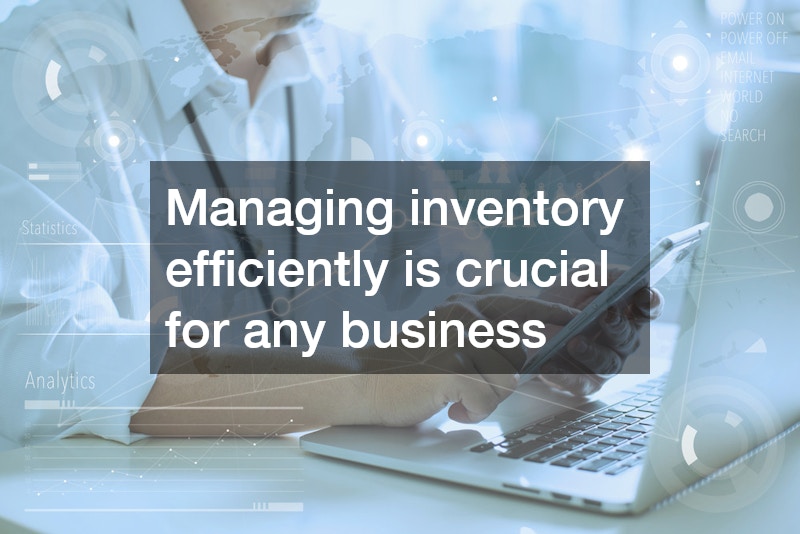
Managing inventory efficiently is crucial for any business, and inventory tracking software plays a key role in ensuring everything runs smoothly. This type of software helps companies keep track of stock levels, order fulfillment, and sales data. By using integrated inventory management, businesses can streamline processes across multiple departments, ensuring that all data is synchronized and up-to-date in real time.

With computerized tracking, manual errors are significantly reduced, allowing for more accurate and timely insights into your product inventory. Whether you’re running a small business or managing a large warehouse, inventory tracking software ensures that you always know what’s in stock, when to reorder, and how much to keep on hand.

There are many inventory tracking methods available, from barcode scanning to RFID technology, each designed to fit different business needs. Choosing the right method depends on factors like the size of your operation and the complexity of your product lines. Regardless of the method used, having the right tools in place is essential to maintaining efficiency.
By leveraging integrated inventory management and computerized tracking, businesses can improve their overall performance, reduce losses, and make more informed decisions regarding their product inventory. Call today and see what difference a personalized approach can make for your inventory tracking needs!

Inventory tracking can be a huge responsibility, so many businesses (and even government entities) let the ball drop all together. It takes so many resources that it can’t be done without a robust government inventory system. However, property inventory and managing how many you keep on hand at any given time is a key piece in a successful operation. If you are searching for ways to improve your inventory process, pay attention to our tips:
Four Tips for Improving Your Inventory Process
-
- Don’t try to reinvent the wheel.
We have three words for you: government inventory system. There are so many factors that you have to keep track of when you manage your own inventory on pen and paper (or even in a fancy Excel doc). You can do it without a government inventory system, but you can’t do it well.
Instead, implement a government inventory system that will essentially put in place the best practices for government inventory management for you. A good, robust system will estimate the fluctuation in demand and supply, and develop the best protocol for replenishing your inventory for you. As development of property inventory management software grows, it becomes more popular and necessary than ever to find a system that will manage your inventory for you, instead of leaving it to you to manage yourself.
When looking for a good inventory management system, look for one that requires as little human interaction as possible in the supply chain. You want a system that just requires approval for controlled items, and otherwise takes care of your inventory management for you.
- Don’t try to reinvent the wheel.
-
- Don’t play inventory system telephone.
Remember the game we all played as children, where you whisper something in one person’s ear, who whispers it in the next person’s ear, and the next. By the time it gets to the last person, the message is so convoluted that it doesn’t resemble the original message at all. You’ll get the same result with the quality and accuracy of your data if you’re relying on several systems to pass the message along. If you use an Excel spreadsheet to manage how much you have of each item in your inventory, and then another system for financial data, and another for demand, and another to slice and dice the data to make strategic decisions, the room for error is great.
Instead, you should look for one platform that handles each piece of the inventory management process. The data coming out of the system is just as accurate as the data going into the system, because there are multiple pit stops along the way to make inaccurate. This is also advantageous because it allows you to pull real time data to guide your decisions, you don’t have to wait until the end of a reporting cycle to review the numbers for the previous cycle.
- Don’t play inventory system telephone.
-
- Be wary of any one-size-fits-all solution.
Of course any government inventory system developers is going to want to convince you that their product will meet all of your needs, no matter what needs you have. If you’re in the food services sector, your inventory management needs are going to be far different than if you’re in the military supply sector. As a result, there really isn’t a single system that meets all government inventory system needs.
Additionally, you don’t want a system that treats all your SKUs the same. Items that you can’t keep on the shelves need to be filled a lot faster than items that move slowly. You need to make sure you look for a government inventory system that can differentiate between this and cater to your specific inventory management needs.
- Be wary of any one-size-fits-all solution.
- Hold your suppliers accountable.
Sometimes one huge area for improvement in your supply chain process is just the timeliness and accuracy of the orders you get from your suppliers. A robust inventory management system will help you catch these issues so they can be addressed and either a new supplier put in place or corrections made to the current supplier. Look for a system that tracks the expected delivery date of supplies and the the date that it is actually received, as well as the amount that was ordered vs. the amount your received. Bonus points for a system that has a field for recording condition.
Questions? Share below!
